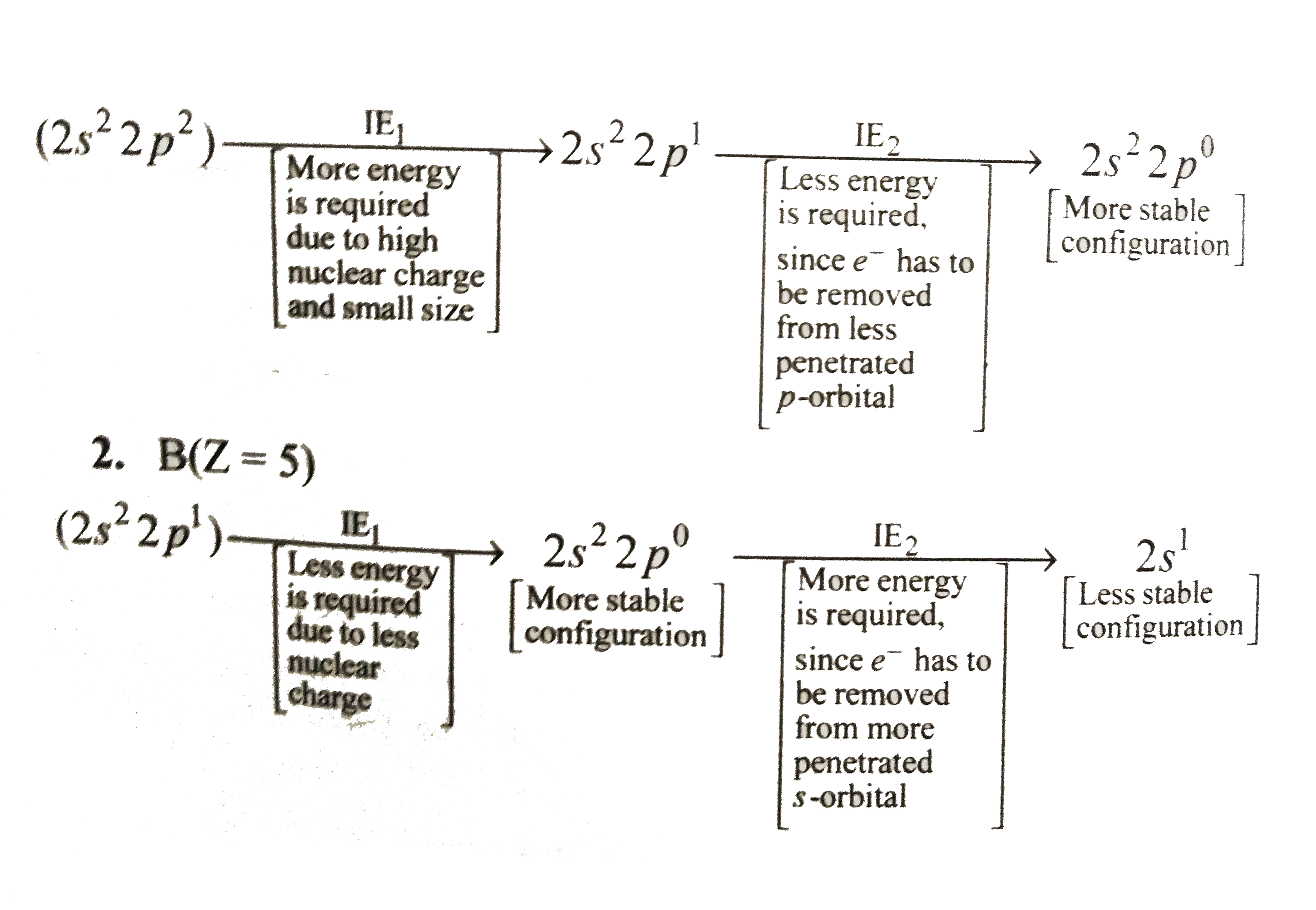Give reason for the following :
a. The first ioisation eathalpy of carbon carbon is greater than that foboron, whereas the reverse is true fore the second ionisation enthalpy .
b. Solid carbon dioxie is known as dry ice .
c. Why does not silicon form an analogue fo graphite ?
a. Electronic configuration of carbon is 1s2,2s2,2s2 , whereas that of boron is 1s22s22p1 . The first ionisation enthalpy of carnon is grater than that of boron due to its smaller size and higher effective nuclear charge . The valence shell electons are nore tightly bound to the nucleus , hence , for its removal grater amount of enrgy is requreed .
The second ionisation enthalpy of carbon is less than that of boron , as the removal fo second electron in carbon has to be doen from 2p orbital whereas in boron it has to gbe done from 2s orbial . First , 2s orbital , therfore , the electrons are more tightly bound . Also 2s2 configuration in C being fully filled is more stable than 2p1 in B Because of these two reasone , IE2 or C<IE2 of B.
Altenrate explanation :

Therefore , IE21 of C>IE1 of B and IE2 of C<IE2 of B
b. Solid carbon dioxdie on veape on evaporation change directly to the gaseous state without changing to the liwuid state . It produces cooling diring evaporation and doen not wet the surface , therefore , solid CO2 is known as dry ice .
c. Due to small size and high electronegativity of C , it is capable of forming pπ−pπ bond , which occures in graphite , whereas in Si the size of the orbital involmed i.e.,e 3p in pπ−pπ bond formation is large and ghecne multiple bond formation is not freasible Si . Hence silicon does not form an anlogous of grapbite .
Topper's Solved these Questions
- P-BLOCK GROUP 14 - CARBON FAMILYBOOK - CENGAGE CHEMISTRY ENGLISHCHAPTER - P-BLOCK GROUP 14 - CARBON FAMILYEXERCISE - Solved Examples
9 Videos
- P-BLOCK GROUP 14 - CARBON FAMILYBOOK - CENGAGE CHEMISTRY ENGLISHCHAPTER - P-BLOCK GROUP 14 - CARBON FAMILYEXERCISE - Ex (Subjective)
21 Videos
- P-BLOCK GROUP 13 - BORON FAMILYBOOK - CENGAGE CHEMISTRY ENGLISHCHAPTER - P-BLOCK GROUP 13 - BORON FAMILYEXERCISE - Exercise Archives (Subjecive)
9 Videos
- PERIODIC CLASSIFICATION OF ELEMENTS AND GENERAL INORGANIC CHEMISTRYBOOK - CENGAGE CHEMISTRY ENGLISHCHAPTER - PERIODIC CLASSIFICATION OF ELEMENTS AND GENERAL INORGANIC CHEMISTRYEXERCISE - Exercises (Archives )Subjective
4 Videos
Similar Questions
Why the first ionisation energy of carbon atom is greater than that of boron atom whereas, the reverse is true for the second ionisation energy.
View SolutionThe first ionisation enthalpy of nitrogen (Z=7) is greater than that of oxygen (Z =8) but the reverse is true for the second ionisation enthalpy. Explain why.
View SolutionGive reason for the following in one or two sentences : ''Solid carbon dioxide is known as dry ice.''
View SolutionGive reason for the following.
a) Covalent bonds are directional bonds while ionic bonds are non-directional.
b) Wate molecules has bent whereas carbon dioxide molecule is linear.
c) Ethyne molecule is linear.
View SolutionGive reasons for the following
(a) CCl4 is immiscible in water, whereas SiCl4 is easily hydrolysed.
(b) Carbon has a strong tendency for catenation compared to silicon.
View Solution(a) When a chromite ore (A) is fused with an aqueous solution of sodium carbonate in free excess of air, a yellow solution of compound (B) is obtained. This solution is filtered and acidified with sulphuric acid to form compound (C). Compound (C) on treatment with solution of KCl gives orange crystals of compound (D). Write the chemical formulae of compounds A to D.
(b) Describe the cause of the following variations with respect to lanthanoids and actinoids:
(i) Greater range of oxidation states of actinoids as compared to lanthanoids.
(ii) Greater actinoid contraction as compared to lanthanoid contraction.
(iii) Lower ionisation enthalpy of early actinoids as compared to the early lanthanoids.
View SolutionWrite the balanced chemical equations for the following reactions and identify the type of reaction in each case.
(a) Iron (III) oxide reacts with aluminium and gives molten iron and aluminium oxide.
(b) Magnesium ribbon is burnt in an atmosphere of nitrogen gas to form solid magnesium nitride.
(c) Chlorine gas is passed in an aqueous potassium iodide solution to form potassium chloride solution and solid iodine.
(d) Ethanol is burnt in air to form carbon dioxide, water and releases heat.
View SolutionWhy does elemental silicon not form a graphite-like structure, whereas carbon does?
View SolutionExplain the following
(a) CO2 is a gas whereas SiO2 is a solid
(b) Silicon forms SiF2−6 ion whereas corresponding fluoro compound of carbon is not known.
View SolutionHow many of the following statements are correct regarding allotropes of carbon:
(a) Graphite is not a good conductor of electicity in perpendicular direction of layers at ordinary temperatures.
(b) Coke is the impure form of carbon.
( c) Anthracite is the purest form of carbon.
(d) Buckminister fullerence contains 12 five membered rings and 20 six-membered rings.
(e) Diamond is a good conductor of heat.
(f) Graphite is diamagnetic in nature.
(g) Graphite is thermodynamically more stable than diamond
View Solution
